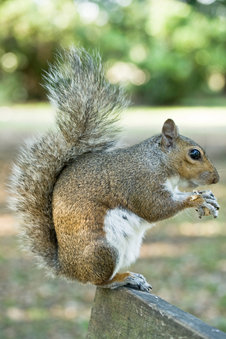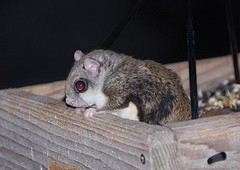“You should know now that a man of knowledge lives by acting, not by thinking about acting, nor by thinking about what he will think when he has finished acting. A man of knowledge chooses a path with heart and follows it” Carlos Castaneda
Squirrels
Is it me? Or did the squirrel population seem to explode over the past few years. It seems like everywhere I look in my yard there are squirrels scurrying and jumping from tree to tree, sometimes appearing to play a fun game of tag. They are truly resilient mammals that have learned to adapt well within the residential neighborhoods that we choose to live in. These cute little critters will rip holes in your vents, eaves, soffits and fascia boards. They will claw and rip at your siding. They will dig tunnels throughout your attic insulation and they will chew, chew and then chew some more on whatever they can get their teeth on whether it be your electrical wires, cable wires, security system, you name it and we have come across it. Did you know that authorities state that 25% to 50% of fires having unknown origins are most likely caused by animals chewing on electrical wires…and guess who the number one culprit is, Squirrels. If you have a squirrel issue in your commercial or residential property, Who You Gonna Call? Wildlife Busters at 1-855-945-1212. We pride ourselves on providing professional, humane solutions to human wildlife conflicts.
The Squirrels belong to the order Rodentia with 1650 species; it is the largest group of living mammals. There are over 365 species of squirrels in seven families including the tree squirrel, ground squirrel and flying squirrel. There are two types of squirrels that are common in our area, the Gray Squirrel and the Northern Flying Squirrel. These squirrels become most active in the late winter, when the mating season begins. The males will chase females, as well as, chase off other suitors. This ritual of chasing occurs through the trees at top speed. While they perform some of the most breathtaking acrobatics imaginable. This is the game of “tag” I was mentioning, but it’s not tag it’s all about defending your territory and finding a mate. A female squirrel will choose the strongest male during mating season, but is unlikely to breed with that male again. This is natures way of reducing inbreeding, and to preserve the species. During winter storms, or severe cold, the squirrel may not leave the nest for days, but squirrels do not hibernate.
Fun Animal Fact of the Month
The word “squirrel” means “shadow tail” in Greek.
Squirrels have some unique physical characteristics. Squirrels can jump a distance of up to 20 feet. This is because they have long, muscular hind legs and short front legs that work together to aid in leaping. The hind legs are double jointed. This helps them run up and down trees quickly. Squirrels have 5 toes on their back feet and 4 toes on their front. Their front toes are very sharp and help in gripping tree bark for climbing. Squirrels eyes are positioned in such a way that they can see some things behind them. All of these features allow the squirrel to adapt very well in an ever expanding residential area. It assists them with gaining access to your attic or crawl space and reeking havoc on your property. As mentioned earlier, a squirrel must chew. This is because squirrels teeth grow continuously. Their incisor’s will grow six inches per year, but they stay short because of the constant chewing that they do, and that is a potential hazard or liability to you, your family or if a commercial property, your employees, clients or tenants. If you believe you have a squirrel issue, give Wildlife Busters a call at 1-855-945-1212 and we will permanently resolve your human wildlife circumstance in a professional and humane manner.

The gray squirrel is 18” to 20” long with the tail being half of that length weighing 1 to 1.5 lbs. They are grey above and white below and in the summer their head, legs and sides become washed with tawny brown. Their eye ring is puffy and their tail is long and bushy. The gray squirrel typically breeds from mid December through January have young in February and March. Gray squirrels typically have 2 to 4 young and may have a second litter in June or July. Their diet consists of nuts, seeds and fruit. They will eat bird eggs and bugs and even an animal carcass if there is no other food source available.

The northern flying squirrel is 10” to 11” long including a 4.5” tail, weighing 3 to 4 ounces. Their dense soft fur is grayish brown above and a creamy white underneath. The eyes of the flying squirrel are exceptionally large in relation to its body size. At a glance the flying squirrel looks like it is ‘flying’, but in reality it glides from branch to branch. The most noticeable feature is the loose fold of skin, which extends from the wrists of the forearm to the ankles of the hind legs. This fold of skin is stretched when the legs are extended to form a wing-like surface that allows the flying squirrel to glide from tree to tree. The tail is furred and flattened. The northern flying squirrel typically breeds in late winter having young in April or May. They will typically have 2 to 7 young.
Best Practices
- If anyone is feeding the squirrels, persuade them to stop.
- There are metal bird feeders that close once the squirrel jumps onto them, which are effective. Other feeder designs can be modified to make them more squirrel-proof. Place a stovepipe baffle (min. length 2 1/2 ft.) on the pole, at least four feet off the ground. Or hang the feeder on a rope between two pulleys.
- Keep the area underneath the feeder clean.
- Enclose compost piles in a framed box using hardware cloth or welded wire; in a sturdy container, such as a 55-gallon drum; or in a commercial composter.
- Feed pets indoors.
Community Wildlife Programs and Upcoming Events
Mohonk Preserve. April 18-22 is “Take a Child Outside Week” During this week The Preserve will offer free admission during the mid-week period only (no weekends) for children and an accompanying adult (1 adult per child). For more information please visit www.mohonkpreserve.org
Museum of Hudson Highlands. Every Sat. & Sun. in March at the Outdoor Discovery Center, are Maple Sugaring Tours from 10:30 am & 3:00 pm. Saturday April 30th. Earth Day Celebration and Rummage Sale from 10 am to 3 pm. For more information please visit; www.museumhudsonhighlands.org
Weinberg Nature Center. Sundays March 27th., April 3rd & 17th Meet our Resident Animals, 11 am to 12 pm and 2 pm to 3pm. Sunday May 22rd. 2011 Spring Eco-Fest from 12 pm to 4 pm. For more information please visit; www.weinbergnaturecenter.org
Beczak Environmental Education Center. Saturday March 19th & 26th, Mammals of the Hudson, 11 am to 12 pm. For more information please visit; www.beczak.org
And for some Wildlife fun all year round visit:
www.palisadesparksconservancy.org The Bear Mountain Zoo located in the Bear Mountain State Park, NY

 Receive FREE wildlife Tips!
Receive FREE wildlife Tips!
